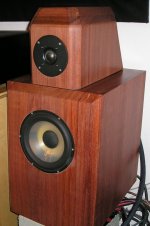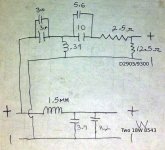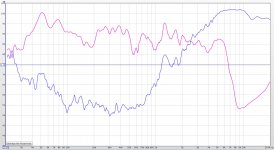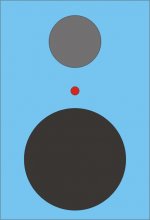Hi guys! One of the speaker designs I've built in the past (1996), see pic attached, is still in use today and I'm wanting to get some feedback on whether tweeter technology has come far enough over the last 20 years to warrant an upgrade.
The speakers have the original Scan-Speak D2905/9300 tweeters still installed. (datasheet)
(The other drivers in case you are curious are the Scan Speak 18W 8543 poly mid woofers, also vintage. These can't be changed out as this is an isobaric design and the inner drivers are sealed inside.)
The crossover is in an external case so no problem redoing it.
So, some of the options that would work in place of the Scan-Speak D2905/9300's without redoing the cabinet much would be:
SB Acoustics SB29RDC-C000-4
SEAS Prestige 27TBFC/G (H1212)
Dayton Audio RS28A-4
Worth changing out? Opinions on best 105mm tweeter?
Happy holidays guys.
Ben
The speakers have the original Scan-Speak D2905/9300 tweeters still installed. (datasheet)
(The other drivers in case you are curious are the Scan Speak 18W 8543 poly mid woofers, also vintage. These can't be changed out as this is an isobaric design and the inner drivers are sealed inside.)
The crossover is in an external case so no problem redoing it.
So, some of the options that would work in place of the Scan-Speak D2905/9300's without redoing the cabinet much would be:
SB Acoustics SB29RDC-C000-4
SEAS Prestige 27TBFC/G (H1212)
Dayton Audio RS28A-4
Worth changing out? Opinions on best 105mm tweeter?
Happy holidays guys.
Ben
Attachments
Compared to the SS 9500 the SB29 has better distortion performance especially at 2khz, and it has a decent sensitivity advantage. It would allow a much lower crossover point. All of the tweeters mentioned have been crossed below 2khz in multiple designs.
Noticeably sound better? One way to find out.
Noticeably sound better? One way to find out.
Hi guys! One of the speaker designs I've built in the past (1996), see pic attached, is still in use today and I'm wanting to get some feedback on whether tweeter technology has come far enough over the last 20 years to warrant an upgrade.
Have you considered or are you considering ribbons?
Have you considered or are you considering ribbons?
Yes sir, but the flange would have to be round 105mm.
Maybe a Satori tweeter, looks like it has the same flange as the SB29.
Worth the price at all over the SB29 though?
There is no point in exchanging the tweeter in your case.
Can you elaborate? I promise to not be insulted, I'm just interested to hear your thoughts -- thanks.
Yes Ben, I can elaborate. By any objective standard, your tweeters are
high quality products and the fact that these are made or designed
two decades ago or even more, does not negate its quality. There were
many commercial products based on that technology, no matter the
actual model. Scan Speak soft dome tweeters have always been among
top of the line choice for higher priced speakers.
The only real potential of possible upgrade to the sound of your speakers
would be working on the XO filter. I am not sure the DIYers are aware of it.
I have spent lots of my funds on different drive units just to discover that
I was mislead to believe there were significant differences between different
brands and models.
If you had a 2 $ tweeter installed in place of the SS, I would have suggested
one of your mentioned units for an upgrade, which is not really the case,
otherwise not.
Merry Christmas!
high quality products and the fact that these are made or designed
two decades ago or even more, does not negate its quality. There were
many commercial products based on that technology, no matter the
actual model. Scan Speak soft dome tweeters have always been among
top of the line choice for higher priced speakers.
The only real potential of possible upgrade to the sound of your speakers
would be working on the XO filter. I am not sure the DIYers are aware of it.
I have spent lots of my funds on different drive units just to discover that
I was mislead to believe there were significant differences between different
brands and models.
If you had a 2 $ tweeter installed in place of the SS, I would have suggested
one of your mentioned units for an upgrade, which is not really the case,
otherwise not.
Merry Christmas!
Worth the price at all over the SB29 though?
Most articles I've read on the subject say the SB29 is a great budget tweet, but Satori is def a class above
The Scanspeak D2905/9300 is one of those classic state-of-the-art ferrofluid soft dome tweeters. Most people who really understand the speaker game know that ALL drivers and speakers are a compromise.
But there are some interesting variations on tweeters. Metal domes are very revealing albeit they have a metallic twangy sound signature. SEAS metal domes are worth a look.
H1212-06 27TBFC/G
Ring-radiators like SB acoustics SB29 and Vifa XT25 have some strengths too. Very clear top end due to pinning the centre which has all sorts of resonance problems in soft domes.
Even cone tweeters are worth considering, if you ignore their dispersion problems and need for high crossover above 3kHz. They can sound very musical.
I see you have the Scanspeak 18W-8543 woofer. A nice low-inductance polycone design.
http://www.scan-speak.dk/datasheet/archive/18w-8543-00.pdf
This seems to cry out for third order butterworth filtering. You usually put back the inductance with a bass filter around 1.8mH/6.8uf/0.6mH. Tweeter filter near 6.8uF/0.2mH/6.8uF and attenuation to suit. You see, the sound is all in the crossover.
SB Acoustics :: Eka
But there are some interesting variations on tweeters. Metal domes are very revealing albeit they have a metallic twangy sound signature. SEAS metal domes are worth a look.
H1212-06 27TBFC/G
Ring-radiators like SB acoustics SB29 and Vifa XT25 have some strengths too. Very clear top end due to pinning the centre which has all sorts of resonance problems in soft domes.
Even cone tweeters are worth considering, if you ignore their dispersion problems and need for high crossover above 3kHz. They can sound very musical.
I see you have the Scanspeak 18W-8543 woofer. A nice low-inductance polycone design.
http://www.scan-speak.dk/datasheet/archive/18w-8543-00.pdf
This seems to cry out for third order butterworth filtering. You usually put back the inductance with a bass filter around 1.8mH/6.8uf/0.6mH. Tweeter filter near 6.8uF/0.2mH/6.8uF and attenuation to suit. You see, the sound is all in the crossover.
SB Acoustics :: Eka
I appreciate the help -
On the crossover, I have something like attached napkin sketch.
I have also attached the tweeter and woofer response curves separately measured with REW and my trusty radio shack SPL meter at 1m. Woofers pink, tweeter blue. 1/12 smoothing. This is through the current crossover, just disconnected the woofers, then disconnected the tweeter to take the measurements.
Remember, two 18W-8543, isobaric configuration.
Any discussion appreciated.
On the crossover, I have something like attached napkin sketch.
I have also attached the tweeter and woofer response curves separately measured with REW and my trusty radio shack SPL meter at 1m. Woofers pink, tweeter blue. 1/12 smoothing. This is through the current crossover, just disconnected the woofers, then disconnected the tweeter to take the measurements.
Remember, two 18W-8543, isobaric configuration.
Any discussion appreciated.
Attachments
Last edited:
Well that crossover is clearly a train wreak.
Hi 5th element.
Care to elaborate? I can see the tweeter level is a bit high but you cannot hear that in the sound at all. In fact, it almost seems like the highs are not really there very much! Also, the ripples in the lower registers are probably room interactions. There is a relatively loud fan from the computer taking the measurements as well.
Do you guys think I should make a new thread for crossover help or keep posting here?
-- Ben
I don't think you need a new thread. I'll assume your measurement mic
works OK. Make sure your box is stuffed appropriately. There is a dip
around 650 Hz and it may be a standing wave( 0,26 m).
Do the measurements with a mic set at 1m without the XO filter,
each driver separately without moving the mic from its position.
Measure the impedance of drivers in the box, isobaric pair separately, tweeter
separately.
Export the measurement .txt files here as attachments .
( IsoFR.txt(bassmid FR), IsoIMP.txt(bassmid IMP),TwFR.txt(tweeter FR)
and TwIMP.txt(tweeter IMP)
We could use them for simulating a frequency response and come up with
a proposal of probable improvement.
works OK. Make sure your box is stuffed appropriately. There is a dip
around 650 Hz and it may be a standing wave( 0,26 m).
Do the measurements with a mic set at 1m without the XO filter,
each driver separately without moving the mic from its position.
Measure the impedance of drivers in the box, isobaric pair separately, tweeter
separately.
Export the measurement .txt files here as attachments .
( IsoFR.txt(bassmid FR), IsoIMP.txt(bassmid IMP),TwFR.txt(tweeter FR)
and TwIMP.txt(tweeter IMP)
We could use them for simulating a frequency response and come up with
a proposal of probable improvement.
Attachments
Thank you for your offer of assistance, Lojzek, it is greatly appreciated. My plan is to purchase a microphone, namely the Dayton UMM-6 in order to take better measurements. When I have that, I will move the speaker away from the furniture a bit to minimize reflections and take a set of gated measurements without the crossover in the mix.
Hi Ben,
+1 new Xover is best investment
PREMISE: you want to keep your beautiful real-wood cabinets and use latest tech to improve sonics.
BEST: Keep current drivers and experiment with new LR4 Xover at 2KHz.
OPTION: Keep tweeter. Replace 18W 8543 with latest/greatest paper cone + new Xover
FUTURE: DIY a 3-way. Optimal tweeter + optimal midrange + optimal Bass.
1) The D2905/9300 is an excellent tweeter. I would not spend money to replace it, unless you want to learn by experimenting with a significantly different design like the SB29RDC ring radiator which can support a 1800Hz LR2/LR4.
2) The 18W 8543 poly mid woofers has an excellent low Le motor, but a "soft sounding" plastic cone. You will get a large change in sonics if you replace the 18W 8543 with a latest/greatest paper cone. ?better?
3) Your 2-piece cabinet supports T-M physical time alignment, which allows simple and often superior crossover circuits.
4) Your 2-piece cabinet creates a larger-than-minimum center-to-center T-M separation, which often creates lobing and comb filtering. With large C-to-C, a LR4 usually sounds better than LR2 . Simulate LR4 at 1800Hz and 2000Hz.
5) You can Google D2905/9300 and 18W 8543 for Xover topos to study/simulate. FRD SPL/freq files for "Passive Crossover Designer" program are available. Measurements on your speakers in your cabinet are necessary for a decent sounding xover. Simulate...simulate....simulate. Passive parts are expensive.
SpeakerBuilding.com - Making of M1 - Print
+1 new Xover is best investment
PREMISE: you want to keep your beautiful real-wood cabinets and use latest tech to improve sonics.
BEST: Keep current drivers and experiment with new LR4 Xover at 2KHz.
OPTION: Keep tweeter. Replace 18W 8543 with latest/greatest paper cone + new Xover
FUTURE: DIY a 3-way. Optimal tweeter + optimal midrange + optimal Bass.
1) The D2905/9300 is an excellent tweeter. I would not spend money to replace it, unless you want to learn by experimenting with a significantly different design like the SB29RDC ring radiator which can support a 1800Hz LR2/LR4.
2) The 18W 8543 poly mid woofers has an excellent low Le motor, but a "soft sounding" plastic cone. You will get a large change in sonics if you replace the 18W 8543 with a latest/greatest paper cone. ?better?
3) Your 2-piece cabinet supports T-M physical time alignment, which allows simple and often superior crossover circuits.
4) Your 2-piece cabinet creates a larger-than-minimum center-to-center T-M separation, which often creates lobing and comb filtering. With large C-to-C, a LR4 usually sounds better than LR2 . Simulate LR4 at 1800Hz and 2000Hz.
5) You can Google D2905/9300 and 18W 8543 for Xover topos to study/simulate. FRD SPL/freq files for "Passive Crossover Designer" program are available. Measurements on your speakers in your cabinet are necessary for a decent sounding xover. Simulate...simulate....simulate. Passive parts are expensive.
SpeakerBuilding.com - Making of M1 - Print
- Status
- This old topic is closed. If you want to reopen this topic, contact a moderator using the "Report Post" button.
- Home
- Loudspeakers
- Multi-Way
- Best 105mm Tweeter SB SB29RDC, SEAS 27TBFCG, Dayton RS28A4, etc



